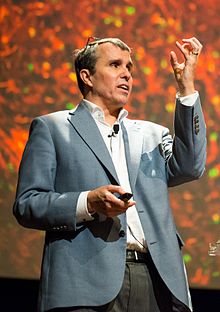Eric Betzig
Appearance
Eric Betzig | |
|---|---|
 | |
| Born | Robert Eric Betzig[1] January 13, 1960 Ann Arbor, Michigan, U.S. |
| Alma mater | California Institute of Technology Cornell University |
| Known for | Photoactivated localization microscopy Lattice light-sheet microscopy |
| Awards | |
| Scientific career | |
| Fields | Applied physics |
| Institutions | Howard Hughes Medical Institute University of California, Berkeley |
| Thesis | Near-field Scanning Optical Microscopy (1988) |
| Doctoral advisor | Aaron Lewis, Michael Isaacson |
| Influences | William E. Moerner |
| Website | hhmi |
Robert Eric Betzig (born January 13, 1960) is an American physicist. He works as a Professor of Physics and Professor of Molecular and Cell biology at the University of California, Berkeley.[2][3][4] He is also a Senior Fellow at the Janelia Farm Research Campus in Ashburn, Virginia.[5]
Betzig has worked to develop the field of fluorescence microscopy and photoactivated localization microscopy.
He was awarded the 2014 Nobel Prize in Chemistry for "the development of super-resolved fluorescence microscopy"[6] along with Stefan Hell and fellow Cornell alumnus William E. Moerner.[7]
References
[change | change source]- ↑ "Eighty-Ninth Annual Commencement – California Institute of Technology" (PDF). caltechcampuspubs.library.caltech.edu. California Institute of Technology. June 10, 1983. Retrieved October 11, 2014.
- ↑ "Eric Betzig | UC Berkeley Physics". physics.berkeley.edu. Retrieved 2019-07-18.
- ↑ "Eric Betzig | Research UC Berkeley". vcresearch.berkeley.edu. Retrieved 2019-07-18.
- ↑ "Eric Betzig". HHMI.org. Retrieved 2019-07-18.
- ↑ "Eric Betzig, PhD". hhmi.org. Howard Hughes Medical Institute. Retrieved 2014-10-08.
- ↑ "The Nobel Prize in Chemistry 2014". Nobelprize.org. Nobel Media AB. 2014-10-08. Retrieved 2014-10-08.
- ↑ "Eric Betzig Wins 2014 Nobel Prize in Chemistry". HHMI News. hhmi.org. 2014-10-08. Retrieved 2014-10-08.
